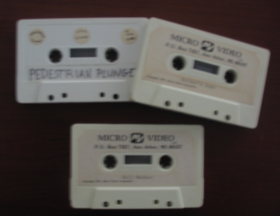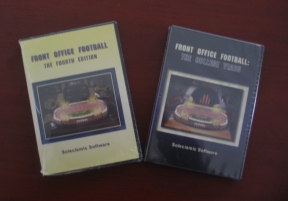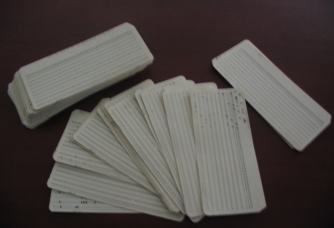

|
|
|
Solecismic Software is an entertainment software company dedicated to producing cutting-edge career football simulations.
I'm Jim Gindin, a programmer living in Canton, Ohio. I've always been fascinated
with sports, and I've been designing games since I was old enough to roll dice.
For a long time, I worked as a sportswriter, including six years part time at The
Ann Arbor News while I worked my way through college.

I was first exposed to computers in 1976, when I took a summer class for elementary school students taught by the Ann Arbor school district. We learned BASIC on a county-wide mainframe system. We would dial the mainframe, and place the telephone in a rather bulky modem-like device called an acoustic coupler. Our teacher even demonstrated a working version of the original Altair 8800 computer. My life was changed.
A few years later, I convinced my parents to buy an Interact computer (a lot like a Commodore PET, only it connected to a television like those old Atari game systems). It had a whopping 16K of usable RAM. That's 16,384 bytes, about the size of this web page.
To me, 16K was a vast and unexplored canvas. I quickly started writing games that tested the limits of this computer. While in high school, I developed and sold two games to Micro Video, which maintained and serviced the Interact. One was a stock market simulation and the other a driving game where the goal was to run over pedestrians while avoiding pot holes and oil slicks. Micro Video changed the pedestrians to "gremlins" in the final version, rejecting my original title of "Pedestrian Plunge." I still treasure the original "gold" versions of those two cassette tapes, as they represent the beginning of what's now a life-long pursuit.
I wasn't convinced at the time, though. Despite having the opportunity to take a course in
Pascal (using punch cards, no less) at Michigan while in high school, programming
still wasn't something I thought people did for a living. My father was a professor of English at Michigan, and my parents taught me a deep love of writing and of literature.

A few years later, I had an undergraduate degree in English and economics, and a master's degree in journalism. The newspaper world, however, was beginning to feel the crunch of lower advertising revenue and the profession was flooded with young people inspired by Watergate and the idealism of the post baby-boom generation. My first full year in the business, I made $13,000, usually working 60 hours a week.
I began to realize that the computer I had always seen as a hobby was providing many of my friends with a career. So I returned to school full-time and added a computer science major to my undergraduate degree (you'll find anything's possible when you actually read that massive college rules guide you buried at the bottom of your desk the first day of freshman year).
IBM was waiting when I graduated in 1991, and I moved to Durham, North Carolina. Three years later, I moved to the Seattle area to work for a smaller communications software company. And then I spent a year with a company called Computer Associates, a large programming house.
These jobs gave me experience working with large projects. They also taught me that working as a junior member of large teams saps all the creative enjoyment out of programming.
Late in 1997, my frustration with those large, endless projects grew to the point where I was looking for a major career change. I had thought about creating a sports management game for years. After about seven years in the cubicles, building experience, I began to realize anything was possible.
I decided to leave my job and create Solecismic Software. I began spending all my spare time working on a business plan, hammering out the features of Front Office Football. I began learning all I could about Microsoft's Visual C++ and MFC. In early 1998, I gave my notice, and I was off on my own on February 20. I now celebrate February 20 as "Freedom Day."
The best decision I made, after filing the papers forming the company, was to discard virtually everything I thought I knew about the game of football. I spent a full month simply examining the sport. I broke down play-by-play descriptions for every game played in 1997, something I've been doing nearly every year since. I learned the difference between power runners and finesse runners. I learned what a "go-to receiver" looks like statistically. I created a model for analyzing defensive back performances. I learned how to examine the sport through means and standard deviations. In Front Office Football, the raw statistics translate into ratings that make players perform as they did on the field.
All that statistical work led to a more realistic game simulation. Even though I didn't write a line of code during that month, I learned a tremendous amount about the game of football. Every year, I leave plenty of time to examine statistical aspects of the NFL to ensure the game remains current and to come up with new simulation ideas.
After four months of actual programming (there were nearly 100,000 lines of code in the original main program alone), I contacted a CD-ROM duplicator, sent off the artwork and a master CD, and found myself the proud owner of a product.
The game sold fairly well, especially after Computer Gaming World gave the game its Editors' Choice Award and a 4 1/2-star review. I'm very thankful that the editors were willing to let me demo the product in the first place. The game sold out completely, something I didn't think was possible when all those boxes of CDs were delivered the first week of September 1998.
Even more surprising, the game received considerable media attention. CGW nominated it for its Sports Game of the Year award. At one point, the game was number 60 on CGW's Top 100 list, as voted by its subscribers. The local newspaper sent over a reporter. The AP interviewed me for a national story. I was even featured in one of those in-flight airline magazines.
As the reviews built momentum for the game, publishers began to contact me about writing a sequel. At the time, I wanted to create a college football counterpart to the original game. But publishers wanted an expanded version of the original release.
In April 1999, I signed a contract to write the sequel for Electronic Arts. EA provided art and a programming team to redesign the background screen. I created an ambitious slate of new features for the game, adding a play-calling interface and the ability to move a franchise, among many other features.
Front Office Football 2 was released in August 1999, also receiving an Editors' Choice Award and a 4 1/2-star review from CGW. EA distributed the game through an electronic download/licensing process and reached about five times the number of computers as the original game.
That relationship led to one more major version of the game, Front Office Football 2001.
In 2000 and 2001, I had the opportunity to spend a significant amount of time working on the college game, titled Front Office Football: The College Years. This game was released on July 8, 2001.
This is not an EA game. Rather than wasting valuable development time trying to generate publisher interest, I operated on exactly the same business plan I used for the original game.
The College Years earned a four-star rating from CGW, and was nominated for the Sports Game of the Year by both CGW and Computer Games Magazine. The CDs sold out completely in only four months, so I switched to an electronic download for distribution. That electronic download is still available. The game was updated to version 1.3 in mid-2004, adding the 2004 college schedule. It's a very dated game now, so I've discounted it considerably and will probably take it off of the market at some point soon.

With so many problems plaguing the PC gaming market by 2002, Electronic Arts was no longer interested in continuing the series. I decided to bring Front Office Football back under the Solecismic Software umbrella.
I designed a new play-calling interface, and added dozens of new features to the game, stripping it down to its core and replacing nearly everything. I wanted to return Front Office Football to its roots, and create a platform that would survive for years.
The Fouth Edition, released in October 2002, was nearly twice as large as the original.
Early in 2003, I decided to add multi-player league support and a host of other features designed to create a more complete statistical almanac associated with the game. That development led to Front Office Football 2004, the fifth game in the professional football series. It was released in November 2003.
In October 2006, I released Front Office Football 2007, which revamped the game-planning and statistics reporting segments of the game. I added a few dozen other new features, including Solevision, a viewer for an entire week's worth of play-by-play reports.
Front Office Football 2007 represented my continued committment to providing games that entertain those of us who love the numbers in sports. The game was most recently updated in December 2009, and was almost three times the size of the original.

Late in 2007, I decided to try two very different projects. In September, I opened the Football Frontier, a web site featuring statistical analysis of professional and college football.
This gives me the opportunity to exercise my old journalistic muscles, and keeps me current on the latest statistical trends in the game.
I also decided to write a card game, in an attempt to bring in a small, steady revenue stream. I wanted a game that people could keep on the desktop, and play quickly when they needed a break.
In February 2008, I released Front Office Card Games: Up and Down the River. I doubt there will be more card games in the future, but this was something I wanted to do for a long time, and Up and Down the River (or, "Oh, Hell," as many people know it) is a game I played a lot in college and isn't in most card packages.
You can find Up and Down the River for free on the Downloads page.
In January 2013, I released a physical card/board game based on a design I have for a future Front Office Football play-calling interface. It represents an attempt to create a deck-building game that simulates how coaches design playbooks and call plays. The charts in the game are based on simulation of tens of millions of plays within the Front Office Football engine.
I couldn't come up with a good business model for marketing the card game, though, so it was never published.
After experimenting with projects only distantly related to my core products, I returned to Front Office Football development early in 2013.
I started restructuring the code for this game. Computers are much larger than they were in 1998, and a design that tested the limits of memory back in 1998 needed a fundamental refresh if I were to continue development. I made the code more modular and streamlined, taking out tens of thousands of lines that were somewhat redundant.
Since that effort, I've had a much easier time adding to the code. I was able to replace the scouting and coaching modules without having to backtrack and repeat pieces of the old design. I talked with the most active members of the multi-player Front Office Football community and added many of the features they indicated would keep their leagues vibrant and give commissioners and web developers the opportunity to create even more immersive environments. I added a few more features from my go-list.
In December 2013, I released Front Office Football Seven. I updated it to version 7.0a in January 2014, including a set of graphics created by some of the best artists in the Front Office Football community. The current version is 7.2, and includes 2015 rosters.
In November 2016, I released Front Office Football Eight. This version features a completely redesigned play-calling system. Back in the mid-2000s, I had the opportunity to visit the NFL Hall of Fame Museum in Canton, Ohio. The curator was kind enough to let me spend time in their research archives, and I looked through a lot of material related to how NFL coaches prepare playbooks and play-calling for every game.
I last updated Front Office Football Eight in February 2020.
This inspired a design for how I could convey this effort to customers. I think the new design is quite realistic, though obviously coaches can make more in-game adjustments.
I also opened up the interface to allow customers to handle more information at once, and get from one area of the game to any other area very quickly.
After several false starts, Front Office Football Nine became the focus of development. It was released in October 2023.
Front Office Football Nine features a completely new code base and database, required to support dozens of new features and a completely new interface.
|
|
Copyright © Solecismic Software, 1998-2025. All Rights Reserved.
